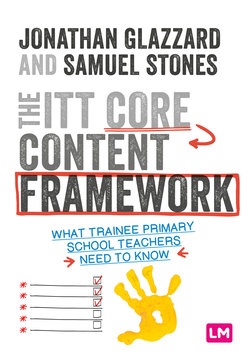Читать книгу The ITT Core Content Framework - Samuel Stones - Страница 19
Creating a safe and stimulating environment
ОглавлениеThe primary classroom should provide a stimulating environment in which children can learn. Children need to be encouraged to respect their learning environment and they are more likely to do this if you also respect it. There should be a place for everything so that children know where to locate resources and storage facilities should be labelled so that children know where resources are kept. Avoid ‘dumping’ your resources in inappropriate places, and aim to be tidy and well organised so that you know where to find things. There is nothing worse than finding a teacher’s resources scattered on a table-top display that is intended for children’s use.
One organisational strategy that you might find useful is to organise your lesson resources into separate boxes or trays each day. Try to get these ready the previous day so that your lessons are prepared when you come into school. Try to devote dedicated time after school each day to preparing your resources for the next day. You can then quickly locate them between lessons and this will help you to stay calm. You will find a system that ultimately works for you, but it is critical that you are organised. If you are not usually an organised person, now is the time to develop this important skill.
Encourage the children to take responsibility for their learning environment. They usually only do this when you communicate high expectations. Examples of ‘non-negotiables’ might include:
A clear expectation that children will tidy their tables at the end of each lesson.
An expectation that no resources or litter will be left on the floor at the end of each lesson or day.
Coats in cloakrooms should be hung on pegs and not left lying around on the floor.
Pencils, pens and rulers should be stored in the appropriate places.
Chairs should be pushed under tables when children leave the classroom.
Assigning ownership of the learning environment to children will make your life easier, but it will also mean that the classroom is tidy and ready for the next lesson. These may seem like minor things that are not important. However, it is all part of what children need to learn and they should be given some ownership of their classroom. Allowing five minutes to tidy away at the end of each lesson will save you a lot of time. You will not have time to keep tidying the classroom between lessons, especially when you are getting your next lesson prepared.
The most stimulating primary classrooms are colourful, interesting and they promote a sense of curiosity. You will need to negotiate with your mentor how much ownership you can have of the learning environment, including displays, but you might find the following suggestions helpful.
Create a stimulus display for your topic to engage children right from the start.
Create interactive displays: create an investigation area to promote children’s curiosity. For example, if the children are learning about electricity, you might place a collection of batteries, wires, bulbs, switches, motors and buzzers onto an investigation table. You might include some learning challenges for them to complete. In this instance, the challenge might include examples of different types of electrical circuits for the children to make. You might then include key questions – for example, ‘How can you make the motor spin the opposite way?’ You might want to include a large diagram of a circuit with key components labelled – for example, battery, bulb, wire, switch.
Create working walls for mathematics and English. These could be changed when you move on to a new unit of work. On the working wall you could include key vocabulary that the children need to learn, worked examples, manipulative mathematical resources and samples of children’s work. In English, the working wall could be created as pupils work through a unit of work to demonstrate the complete writing process – i.e. stimulus, vocabulary generation, planning, drafting, redrafting and the final product.
Create displays of children’s work to celebrate their amazing achievements. Make sure that children’s names are included next to the work. Also display photographs to illustrate the learning process as well as the products of learning – for example, capturing moments when children are working on collaborative tasks.
Create a stimulating reading area that includes texts related to the topics that children are studying.
Create a display about the text that the children are studying in English.
You should expect children to show respect to you, each other and to their learning environment. If your expectations are too low, these will be reflected in their behaviour. Young children learn very quickly what your expectations are. They may test you initially, but when they realise that your expectations will not alter, they usually comply.
You must make sure that the classroom is a safe place for children to learn by removing resources or equipment that might be dangerous. If the school hall is used as a dining room, but also used for physical education, it is worth checking that it is fit to use before you take children in, especially if the policy is for children not to use footwear. Although this might feel like a menial job, it is important to protect children from accidents.
Take 5
Use open questions to promote cognitive demand.
Scaffold questioning to ensure that pupils cannot opt out.
Have routines and procedures in place that support pupils to manage themselves.
Insist that pupils use precise, technical vocabulary.
Communicate regularly with parents in order to establish positive relationships.
